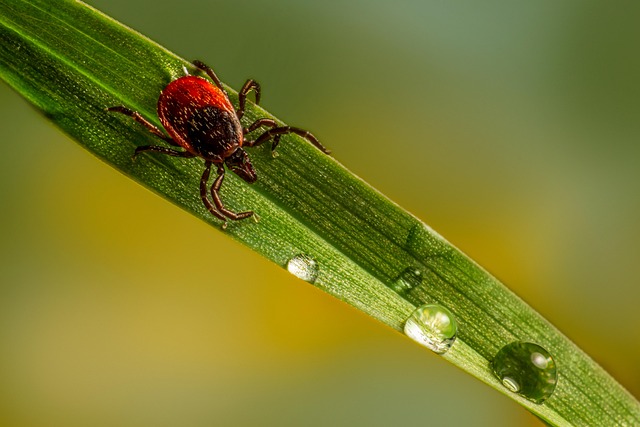Ticks, despite their small size, pose significant health risks through disease transmission via bites, particularly during warm months. Effective residential tick control involves a multi-faceted approach combining eco-conscious practices like yard maintenance, habitat removal, repellent use, and pet treatment with preventative medications. Alternative methods such as Integrated Pest Management (IPM) utilize beneficial insects and cultural practices to minimize tick habitats and physical barriers to prevent access to outdoor spaces. Community collaboration through proper hygiene, education, and regular checks further reduces tick populations, enhancing public health protection while fostering a healthier environment.
In recent years, understanding and managing ticks have become crucial for maintaining both human health and environmental balance. This article explores humane and eco-conscious approaches to tick management, focusing on residential tick control. We delve into the behavior of these vectors of disease, offering insights into their impact on human health. Additionally, we provide practical strategies for implementing eco-friendly methods in homes and gardens, highlighting community efforts and prevention strategies essential for effective tick management.
Understanding Tick Behavior and Their Impact on Human Health
Ticks are minuscule arachnids that, despite their size, pack a significant punch in terms of potential health impacts on humans. Understanding their behavior is crucial for implementing effective residential tick control strategies. Ticks are primarily active during warm months, seeking hosts to feed on blood. They can attach themselves to various animals and, if they bite humans, may transmit diseases such as Lyme disease, Rocky Mountain spotted fever, or anaplasmosis.
Knowledge of tick behavior allows homeowners to take proactive measures in their residential tick control efforts. This includes maintaining a clean yard, removing potential habitats like leaf piles and tall grass, and using repellents or treating pets with preventative medications during peak seasons. By combining these humane and eco-conscious practices, individuals can protect themselves, their families, and local ecosystems from the harmful effects of ticks while also enjoying outdoor spaces safely.
Eco-Friendly Methods for Residential Tick Control
In recent years, there’s been a growing awareness of the importance of humane and eco-conscious approaches to residential tick control. Traditional methods often rely on toxic chemicals that can pose risks to both wildlife and human health. Fortunately, alternative strategies exist that are effective yet environmentally friendly. One such method is integrated pest management (IPM), which combines biological controls like beneficial insects with cultural practices such as yard maintenance and trap placement.
Beneficial insects, such as ladybugs and lacewings, feed on tick eggs and larvae, helping to reduce their population naturally. Additionally, regular mowing, trimming, and cleaning up leaf litter can minimize tick habitats in yards. Property owners can also install physical barriers like mesh screens around patios and decks to prevent ticks from accessing outdoor living spaces. These eco-friendly methods not only protect against ticks but also promote a healthier balance within the local ecosystem.
Integrating Natural Solutions into Your Home and Garden
Integrating natural solutions into your home and garden is a proactive approach to humane and eco-conscious tick management. Instead of relying heavily on chemical pesticides, consider incorporating beneficial insects like ladybugs and lacewings that feed on ticks. Planting tick-repelling herbs such as lavender, rosemary, and marigolds can also help deter ticks naturally. These methods not only reduce the risk of exposure to harmful chemicals but also promote a healthier environment for both you and local wildlife.
At the residential tick control level, maintaining a well-trimmed lawn and removing leaf debris creates less favorable habitats for ticks to thrive. Regularly checking your pets for ticks after they spend time outdoors is another essential practice. By combining these natural solutions with diligent monitoring, you can effectively manage tick populations without resorting to aggressive chemical interventions, contributing to a safer and more sustainable outdoor space.
Community Efforts and Prevention Strategies for Effective Tick Management
Community efforts play a pivotal role in effective tick management, as collaborative actions can significantly reduce tick populations and protect public health. Residents can join forces to implement prevention strategies that create a more hostile environment for ticks. One such strategy is maintaining proper yard hygiene by removing leaf debris, cutting back overgrown vegetation, and ensuring regular mowing. These practices limit tick habitats and make it harder for them to find hosts, thereby reducing the risk of transmission of diseases like Lyme.
Additionally, community-wide education programs can empower residents to become proactive in tick control. Teaching people about tick behavior, common habitats, and effective repellents can foster a collective understanding of prevention. Encouraging residents to regularly check themselves and their pets for ticks after outdoor activities further strengthens these efforts. By combining individual vigilance with community-driven initiatives, such as collaborative tick removal programs or shared resources for residential tick control products, communities can create a more sustainable and eco-conscious approach to managing tick populations.
In light of the above discussions, it’s clear that both individual actions and collective efforts are vital for effective tick management. By understanding tick behavior, adopting eco-friendly methods like natural solutions and community prevention strategies, we can create a more humane and sustainable approach to residential tick control. These measures not only protect human health but also preserve the balance of our ecosystems. Remember that, in today’s world, navigating these challenges with sensitivity towards both humans and nature is key to fostering vibrant, healthy communities.
